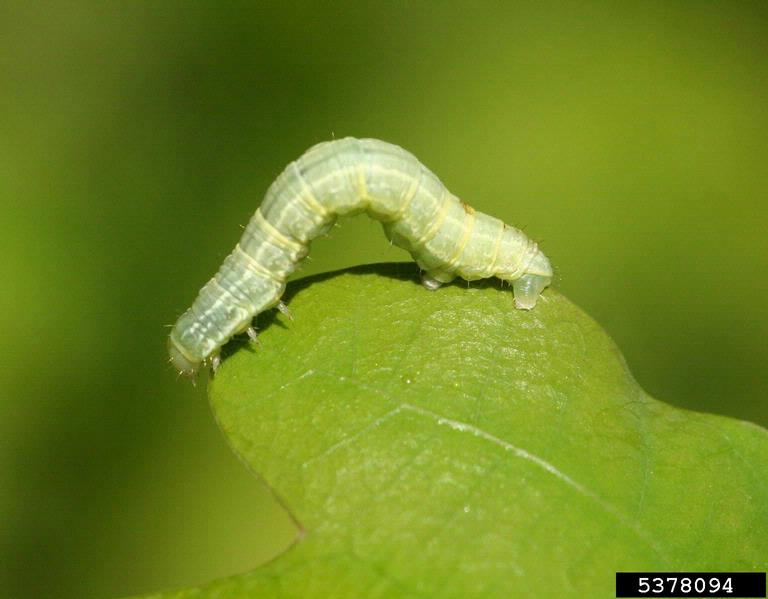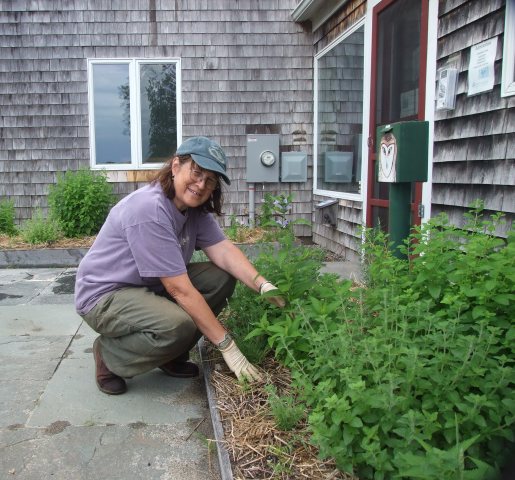
Winter Moth, Milan Zubrik, Forest Research Institute – Slovakia, Bugwood.org
Remember the little pale green caterpillar that ate through your trees and roses last year? Well, it’s back!
The caterpillar stage of the invasive winter moth (Operophtera brumato) eats young, tender leaves, sometimes before the leaves even get a chance to emerge from the bud.
The winter moth caterpillar is just one of hundreds of species of tiny green caterpillars, or inchworms, found in North America. Most are native and ecologically helpful, even though some, like the winter moth, can be a nuisance.
Identifying Winter Moth Caterpillars
It’s easy to tell winter moths apart from beneficial inchworms. The best way is by looking at the back end of an inchworm: If it has only two pairs of legs on its back end, it’s probably a winter moth. More than two pairs of legs on its back end means it’s probably a “good inchworm” and should be let be. Winter moths are also stouter than other inchworms, and have a white stripe along the side.
The Moth Stage
Last November and December you might have seen hundreds of moths on cool winter evenings flying around outdoor lights. They were the male moths. They were out looking for vertical surfaces, like tree trunks, to find the virtually wingless females and mate. Once the moths had mated, the females lay their eggs in the craggy bark of the trees.
The Caterpillar Stage
Through the winter months, the tiny eggs lay waiting for the perfect time to emerge. Early spring, when the temperature and day length are just right, the buds of trees start to open. This is also when the tiny pale green inch-worm-like caterpillars of the winter moth emerge. They then eat their way through the leaves while they are still in the emerging bud. The leaves emerge skeletonized with only their veins remaining or if the leaves had a chance to develop the leaves are peppered with holes.
Assessing the Damage
Most trees can handle a year of this leaf eating if there are not other forms of stress such as drought, insect infestation, or too much sun or shade depending on the tree. Often, they can send out a second flush of leaves. Remember trees and all plants need to have leaves; it is where the process of photosynthesis occurs (ie where the plants make their food).
Providing extra water throughout the season will help trees recover from the stress of defoliation and re-foliation,
What You Can Do
Most people ask what they can do about these leaf-eating caterpillars. Sure there are sprays that can eradicate them. But, keep in mind they are not selective. The spray that kills the caterpillar stage of the winter moth also kills all of the butterflies in their caterpillar stage.
Paper or plastic strips covered with a sticky substance are commercially available to create a barrier that entraps the adult females and caterpillars. Though logical, this method has not proven to be effective for major infestations.
One option is to not plant trees that are extremely affected by the winter moth. Instead of vulnerable trees like crabapples, pears, and weeping cherries, try planting native trees. After they are established, (generally a year), they will be more resistant to forms of stress and better able to withstand the damage done by the winter moth caterpillar.
Learn more about what you can do to control winter moths on our website.
Updated July 2018


 If you have ever been to
If you have ever been to